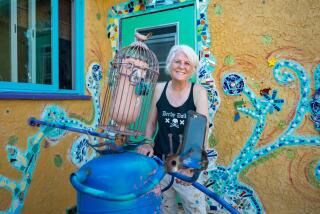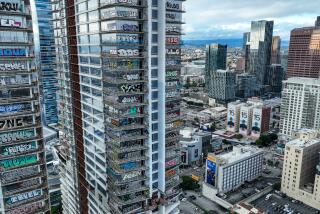Solyndra’s tubes find new life as art
When solar panel manufacturer Solyndra Inc. filed for bankruptcy last year, thousands of employees were let go, dozens of vendors were left high and dry, hundreds of millions of dollars were lost -- and millions of glass tubes were abandoned in a San Jose warehouse.
Now some of those tubes, a signature design element of the company’s cylindrical-shaped solar panels, have found a second life as modern art. Yet like so much about Solyndra, they’ve become another flash point in the controversy surrounding the Fremont, Calif., company.
Oakland architects Ronald Rael and Virginia San Fratello used 1,368 of the glass tubes to create “SOL Grotto,” an architectural sculpture on display in the lush grounds of the UC Botanical Garden in Berkeley. The piece is part of a larger exhibit called Natural Discourse, which features work from a multidisciplinary group of artists, writers, architects and researchers.
But “SOL Grotto” has generated the most publicity as the source of a fresh wave of criticism by conservative commentators and House Republicans, who have long held up Solyndra, which had been awarded a $535-million loan guarantee from the U.S. Department of Energy, as a prime example of wasteful spending by the Obama administration.
Some of those critics are now blasting SOL Grotto as the world’s most expensive piece of taxpayer-funded artwork, even though a U.S. Bankruptcy Court determined that the glass tubes no longer had value.
“UC-Berkeley’s Solyndra Artwork Would Shatter Record for World’s Most Expensive Piece,” read a recent news release from the Republican-dominated House Energy and Commerce Committee, which conducted an exhaustive investigation into Solyndra’s loan guarantee. One Fox News commentator joked that “we could take a sledgehammer to it and call it performance art.”
“SOL Grotto” was conceived not as a political flash point but as a take on the Walden Pond cabin of 18th century philosopher and naturalist Henry David Thoreau. The glass tubes, each of them 3 feet, 9 inches long, penetrate an entire wall of a small shed that has been built in the Botanical Garden on the banks of Strawberry Creek, allowing fresh air and natural light to fill the room. The sound of the creek’s small waterfall is amplified by the glass.
“The best time to see it is in the early morning,” said Rael, as he stood in the doorway to SOL Grotto. “It really changes throughout the day. When the morning fog breaks and the sun comes out, the glass glows brilliantly.”
Rael got the glass tubes from JIT Transportation, a San Jose company that had a contract with Solyndra to transport and store the tubes, which were manufactured overseas. When Solyndra filed for bankruptcy, the company was stuck with about 8 million tubes stacked up on 4,800 pallets, as well as a hefty, unpaid invoice.
“Solyndra owes us about $300,000 for the cost of storing the materials, and they never paid us a penny,” said Gene Ashley, president of JIT. “When I finally contacted the bankruptcy attorney, they had no clue that we even had Solyndra product.”
Ashley is a registered Republican, and the whole experience made him bitter.
“I’m trying to run a small business, and this was just a mess of our tax dollars,” he said. “Obama visited Solyndra and was saying how great it is, but little guys like us were left holding the bag.”
Ashley spent weeks on the phone with bankruptcy attorneys, trying to figure out what to do with all the tubes. He was ultimately told that they had no value and that they were now his responsibility.
Getting rid of them proved to be a challenge. Numerous glass recyclers either didn’t want the tubes or demanded a fee for taking them.
So Ashley and some friends started to put out the word to local and national glass artists. Many were interested, but few could afford the cost of shipping. A glass artist from Carmel took some of the tubes and made a chandelier. When Rael said he wanted some, Ashley was thrilled.
“A while back the TV news did a segment on Solyndra where they showed all of these glass tubes being dumped in a dumpster,” Ashley said. “That really frustrated me. I want people to make some use of it. Luckily, Ron and a few others have tried to put it to good use.”
More to Read
The biggest entertainment stories
Get our big stories about Hollywood, film, television, music, arts, culture and more right in your inbox as soon as they publish.
You may occasionally receive promotional content from the Los Angeles Times.










